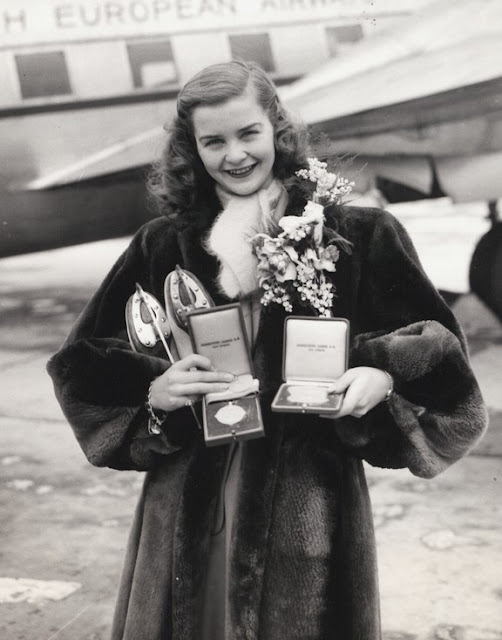So much figure skating history has been made in 2022. Nathan Chen became the first man of Asian American heritage to win an Olympic gold medal in Beijing, landing five quadruple jumps in his winning free skate. At the World Championships in Montpelier, Americans Alexa Knierim and Brandon Frazier became the first American pair in decades to win the World title and Leona Hendrickx won Belgium's first medal in women's figure skating at the World Championships. At Skate America in Norwood, Massachusetts this autumn, Ilia Malinin made history as the first skater to land a quadruple Axel jump in competition on his way to becoming the youngest man ever to win the event. In France, thirty-nine year old Deanna Stellato-Dudek made history as the oldest skater to win an ISU Grand Prix event, with her partner Maxime Deschamps. For the first time, British Ice Skating hosted an ISU Grand Prix event. The MK John Wilson Trophy was not only a huge success from an organizational standpoint but an outstanding competition full of world-class skating. Earlier this month, Skate Canada made an incredibly positive step towards inclusivity in the sport, re-defining its rules for pairs skating and ice dancing to allow any two skaters, regardless of gender, to compete together.
Nathan Chen's winning free skate at the 2022 Winter Olympic Games
Despite the very much ongoing COVID-19 pandemic, figure skating has continued to thrive as a world-class sport and 2023 promises to be even more exciting, if the skating we have seen so far this season is any indication.
What a fun year it has been from a content creator perspective too! I've worked on some really neat things, including the Wearable Skating History project for Pinterest, a host of really interesting articles for "Skating" magazine and U.S. Figure Skating's digital platforms and the compilation of a ton of really obscure figure skating results that weren't readily available previously. Publishing my first book "The Almanac of Canadian Figure Skating" was such a fun learning experience and I can't wait to take the lessons I learned from the process and put them to good use when I publish my next one.
As is the case every year here on Skate Guard, I like to close out the year by doing a little countdown of 10.0 of the most compelling stories that you may have missed over the course of the past year. A Happy New Year to you and here's to more fascinating figure skating history in 2023!
10. THE RINK ON THE RUE PERGOLÉSE
Bringing obscure footnotes to life is one of my favourite aspects of writing about figure skating history. In March, we took a trip back in time to Paris during La Belle Époque and a deep dive into the story of France's plan to build the world's largest artificial ice rink.
9. THE 1907 MINTO SKATING CLUB FIRE
In 1905, the Minto Skating Club's Rideau rink played host to the event now recognized as the first Canadian Figure Skating Championships. Just two years later, the rink was destroyed in a massive inferno, necessitating the cancellation of the Championships. We explored the story back in January.
8. A GRAND DAME OF FRENCH FIGURE SKATING: THE JACQUELINE VAUDECRANE STORY
In the early days, coaching was very much an old boy's club. In October, the blog highlighted the story of legendary barrier-breaking French coach Jacqueline Vaudecrane.
7. THE POWER AND POISON OF THE PEN
Speaking up about injustice is an act of courage. In April, we explored how two pairs skaters in two very different eras used letter-writing to enact change in the skating world.
6. SIXES ACROSS THE BOARD
It's no mistake that this August blog on perfect 6.0's is number six on the list. For decades, a score of perfect six was the benchmark of perfection in the sport and what better way to celebrate those performances that earned a judge's ultimate reward than to catalogue them.
5. FIGURE SKATING AND THE QUEEN
The death of Her Majesty Queen Elizabeth II on September 8, 2022 was inarguably the most significant historical event of the year. Shortly after her death, we highlighted The Queen's many, many connections to the skating world.
4. THE ART OF SPECIAL FIGURES
In 1908, London played host to the only Olympic competition for Special Figures. In August, the forgotten art of special figures was traced in fine detail.
3. A HISTORY-MAKER FROM HYŌGO: THE RYUICHI OBITANI STORY
In February during the Winter Olympic Games in Beijing, it was my great pleasure to share the story of Ryuichi Obitani, one of Japan's great figure skating pioneers.
2. ONE OF A KIND: THE OSBORNE COLSON STORY
Osborne Colson was not only a Canadian Champion, he was one of Canada's most revered coaches of all time. It was my honour to write about him on the blog back in June and spoiler alert: there are some amazing stories in this one!
1. A HISTORY OF DOPING IN FIGURE SKATING
Many of the blogs you read on Skate Guard are written well in advance of the time they are published. That wasn't the case in February, when the doping scandal at the Winter Olympics made international headlines. "A History of Doping in Figure Skating" went viral on Twitter in February, shining a light on an element of the sport's history that needs to be taken incredibly seriously.
Skate Guard is a blog dedicated to preserving the rich, colourful and fascinating history of figure skating. Over ten years, the blog has featured over a thousand free articles covering all aspects of the sport's history, as well as four compelling in-depth features. To read the latest articles, follow the blog on Facebook, Twitter, Pinterest and YouTube. If you enjoy Skate Guard, please show your support for this archive by ordering a copy of figure skating reference books "The Almanac of Canadian Figure Skating", "Technical Merit: A History of Figure Skating Jumps" and "A Bibliography of Figure Skating": https://skateguard1.blogspot.com/p/buy-book.html.

























.png)











.png)






















